
Geospatial technology provider Trimble (NASDAQ: TRMB) reported Q2 CY2025 results exceeding the market’s revenue expectations, but sales were flat year on year at $875.7 million. On top of that, next quarter’s revenue guidance ($870 million at the midpoint) was surprisingly good and 3.6% above what analysts were expecting. Its non-GAAP profit of $0.71 per share was 13.6% above analysts’ consensus estimates.
Is now the time to buy Trimble? Find out by accessing our full research report, it’s free.
Trimble (TRMB) Q2 CY2025 Highlights:
- Revenue: $875.7 million vs analyst estimates of $834.8 million (flat year on year, 4.9% beat)
- Adjusted EPS: $0.71 vs analyst estimates of $0.63 (13.6% beat)
- Adjusted EBITDA: $239.9 million vs analyst estimates of $213.8 million (27.4% margin, 12.2% beat)
- The company lifted its revenue guidance for the full year to $3.52 billion at the midpoint from $3.42 billion, a 2.9% increase
- Management raised its full-year Adjusted EPS guidance to $2.98 at the midpoint, a 3.8% increase
- Operating Margin: 14.6%, up from 7.1% in the same quarter last year
- Free Cash Flow was -$59.4 million, down from $73.3 million in the same quarter last year
- Organic Revenue rose 8% year on year (1% in the same quarter last year)
- Market Capitalization: $19.73 billion
"In the second quarter, the Trimble team delivered record annualized recurring revenue of $2.21 billion and surpassed expectations on both the top and bottom lines. Our results reflect ongoing momentum in the business and continued validation of our Connect & Scale strategy," said Rob Painter, president and CEO of Trimble.
Company Overview
Playing a role in the construction of the Paris Grand, Trimble (NASDAQ: TRMB) offers geospatial devices and technology to the agriculture, construction, transportation, and logistics industries.
Revenue Growth
A company’s long-term performance is an indicator of its overall quality. Any business can experience short-term success, but top-performing ones enjoy sustained growth for years. Over the last five years, Trimble grew its sales at a sluggish 2.7% compounded annual growth rate. This fell short of our benchmarks and is a tough starting point for our analysis.

Long-term growth is the most important, but within industrials, a half-decade historical view may miss new industry trends or demand cycles. Trimble’s performance shows it grew in the past but relinquished its gains over the last two years, as its revenue fell by 1% annually. Trimble isn’t alone in its struggles as the Internet of Things industry experienced a cyclical downturn, with many similar businesses observing lower sales at this time. 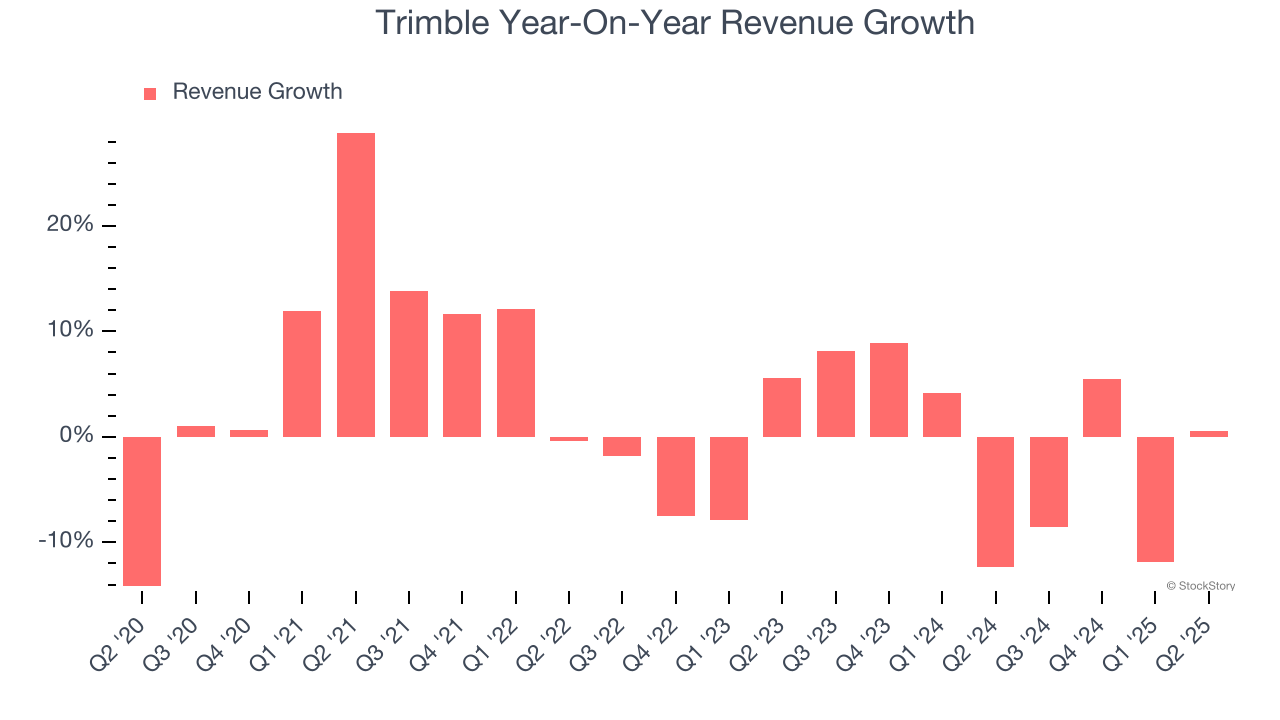
We can better understand the company’s sales dynamics by analyzing its organic revenue, which strips out one-time events like acquisitions and currency fluctuations that don’t accurately reflect its fundamentals. Over the last two years, Trimble’s organic revenue averaged 4.5% year-on-year growth. Because this number is better than its two-year revenue growth, we can see that some mixture of divestitures and foreign exchange rates dampened its headline results. 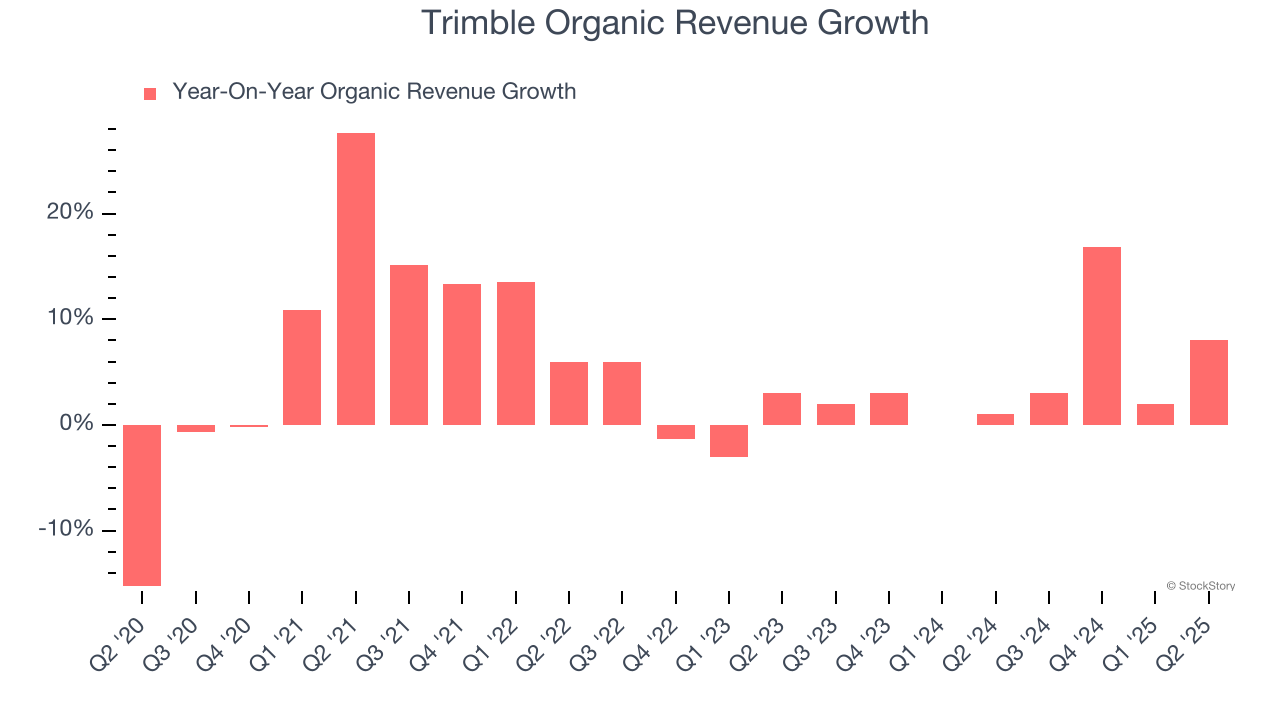
This quarter, Trimble’s $875.7 million of revenue was flat year on year but beat Wall Street’s estimates by 4.9%. Company management is currently guiding for flat sales next quarter.
Looking further ahead, sell-side analysts expect revenue to decline by 2.2% over the next 12 months, similar to its two-year rate. This projection doesn't excite us and implies its products and services will face some demand challenges.
Software is eating the world and there is virtually no industry left that has been untouched by it. That drives increasing demand for tools helping software developers do their jobs, whether it be monitoring critical cloud infrastructure, integrating audio and video functionality, or ensuring smooth content streaming. Click here to access a free report on our 3 favorite stocks to play this generational megatrend.
Operating Margin
Trimble’s operating margin has been trending up over the last 12 months and averaged 13.4% over the last five years. On top of that, its profitability was top-notch for an industrials business, showing it’s an well-run company with an efficient cost structure. This result isn’t surprising as its high gross margin gives it a favorable starting point.
Looking at the trend in its profitability, Trimble’s operating margin might fluctuated slightly but has generally stayed the same over the last five years. This raises questions about the company’s expense base because its revenue growth should have given it leverage on its fixed costs, resulting in better economies of scale and profitability.
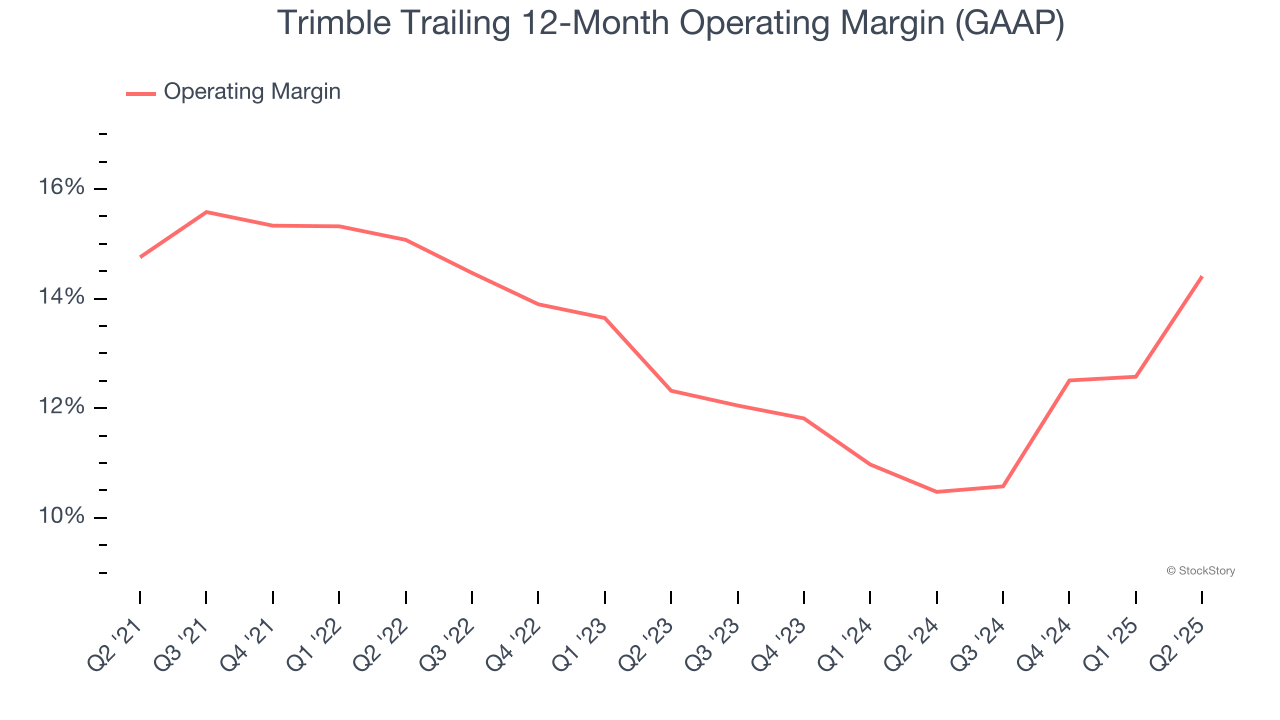
This quarter, Trimble generated an operating margin profit margin of 14.6%, up 7.5 percentage points year on year. The increase was solid, and because its operating margin rose more than its gross margin, we can infer it was more efficient with expenses such as marketing, R&D, and administrative overhead.
Earnings Per Share
We track the long-term change in earnings per share (EPS) for the same reason as long-term revenue growth. Compared to revenue, however, EPS highlights whether a company’s growth is profitable.
Trimble’s EPS grew at an unimpressive 7.6% compounded annual growth rate over the last five years. On the bright side, this performance was better than its 2.7% annualized revenue growth and tells us the company became more profitable on a per-share basis as it expanded.
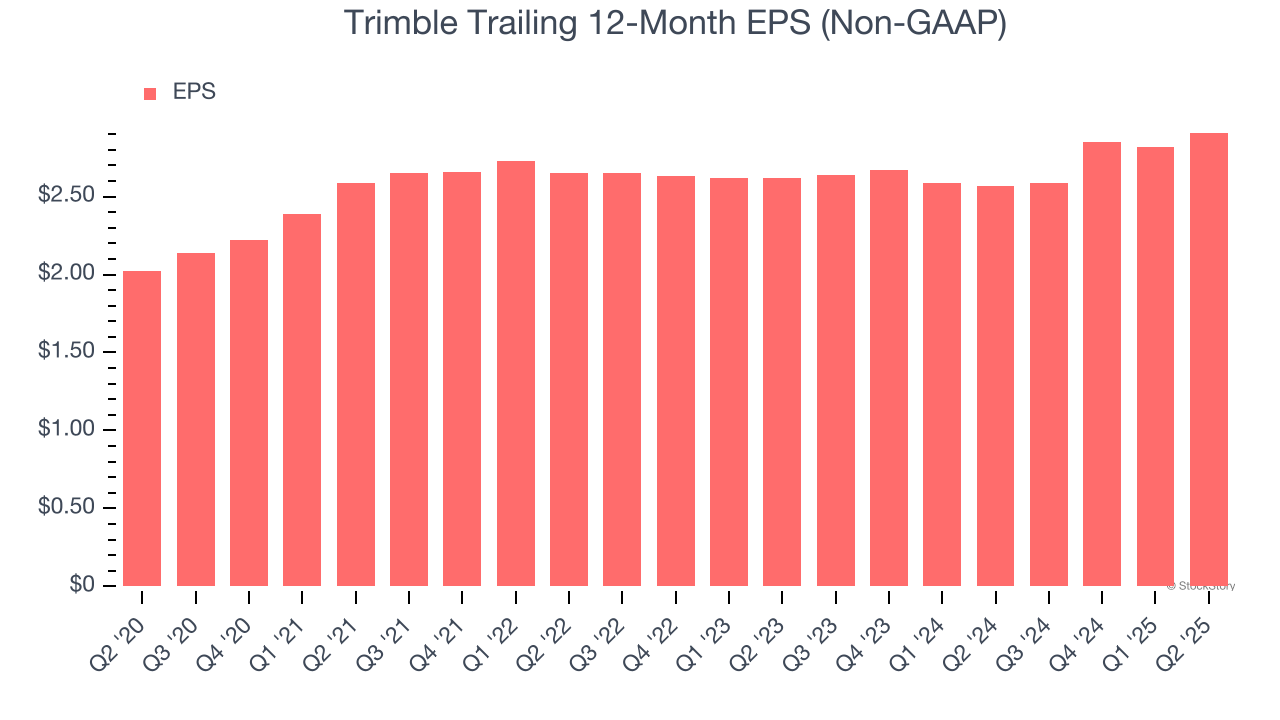
We can take a deeper look into Trimble’s earnings to better understand the drivers of its performance. A five-year view shows that Trimble has repurchased its stock, shrinking its share count by 4.6%. This tells us its EPS outperformed its revenue not because of increased operational efficiency but financial engineering, as buybacks boost per share earnings. 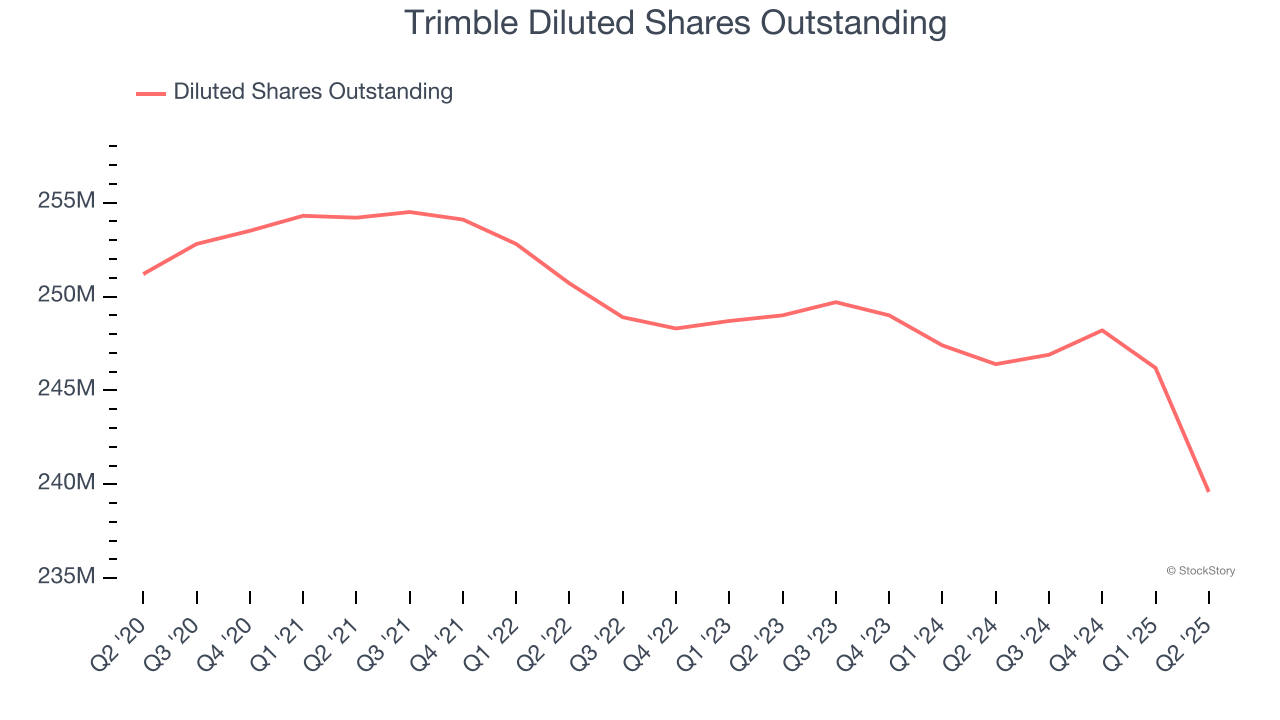
Like with revenue, we analyze EPS over a shorter period to see if we are missing a change in the business.
For Trimble, its two-year annual EPS growth of 5.4% was lower than its five-year trend. We hope its growth can accelerate in the future.
In Q2, Trimble reported adjusted EPS at $0.71, up from $0.62 in the same quarter last year. This print easily cleared analysts’ estimates, and shareholders should be content with the results. Over the next 12 months, Wall Street expects Trimble’s full-year EPS of $2.91 to grow 6.5%.
Key Takeaways from Trimble’s Q2 Results
We were impressed by how significantly Trimble blew past analysts’ revenue and EPS expectations this quarter. We were also excited its full-year revenue and EPS guidance was raised. Zooming out, we think this was a good print with some key areas of upside. The stock traded up 5.1% to $87 immediately following the results.
Sure, Trimble had a solid quarter, but if we look at the bigger picture, is this stock a buy? What happened in the latest quarter matters, but not as much as longer-term business quality and valuation, when deciding whether to invest in this stock. We cover that in our actionable full research report which you can read here, it’s free.







